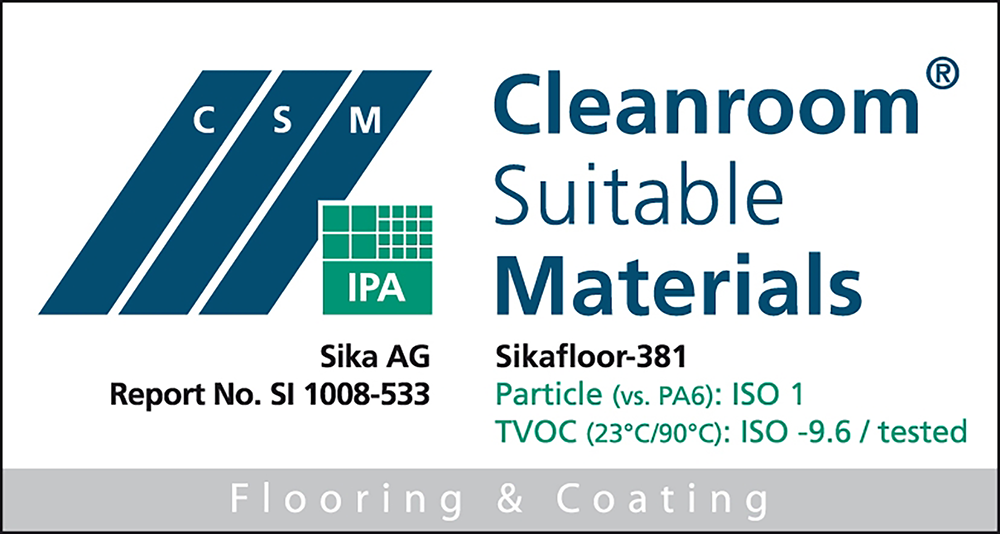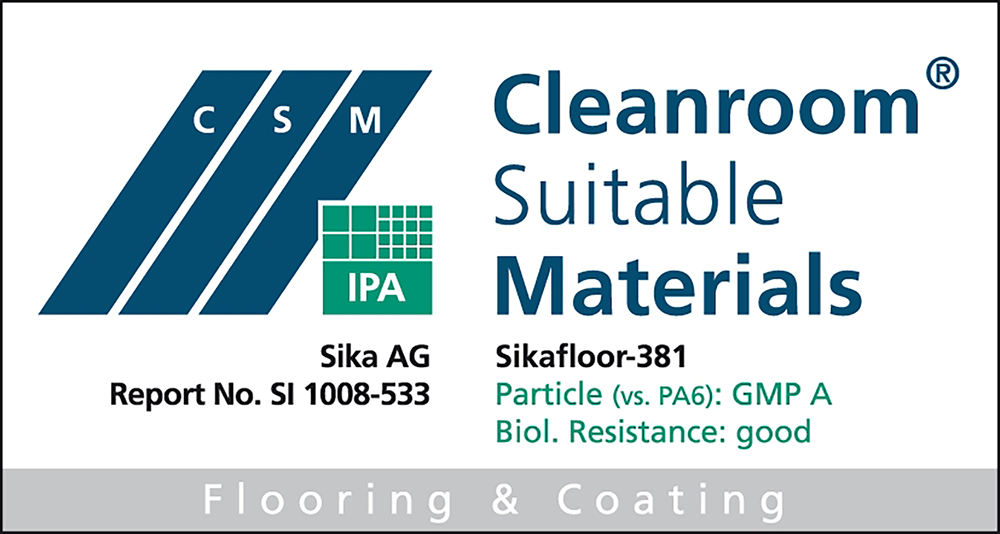Sikafloor®-381
Sikafloor®-381 is a two part, low-emission, self-smoothing, textured and roller coating epoxy resin system designed for cleanrooms. Suitable for use in hot and tropical climatic conditions.
- High chemical resistance
- High mechanical resistance
- Liquid proof
- Abrasion resistant
- Slip resistant surface possible
Usage
Advantages
- High chemical resistance
- High mechanical resistance
- Liquid proof
- Abrasion resistant
- Slip resistant surface possible
Packaging
Part A | 21.25 kg containers |
Part B | 3.75 kg containers |
Part A + B | 25 kg ready to mix units |
Colour
Resin - Part A | Coloured, liquid |
| Hardener - Part B | Transparent, liquid |
Almost unlimited choice of colour shades.
Under direct sun radiation there may be some discolouration and colour deviation, this has no influence on the function and performance of the coating.
Product Details
SUSTAINABILITY
Conformity with LEED v2009 IEQc 4.2: Low-Emitting Materials - Paints and Coatings
APPROVALS / CERTIFICATES
- Particle emission certificate Sikafloor®-381 CSM Statement of Qualification - ISO 14644-1, class 1 - Report No. SI 1008-533 and GMP class A, Report No. SI 1008-533.
- Outgassing emission certificate Sikafloor®-381 CSM Statement of Qualification - ISO 14644-8, class - 9.6 - Report No. SI 1008-533.
- Good biological resistance in accordance with ISO 846, CSM Report No. 1008 - 533
- Synthetic resin screed material according to EN 13813 : 2002, Declaration of Performance 02 08 11 02 002 0 000051 1008, certified by notified factory production control certification body 0921, certificate of conformity of the factory production control 2017, and provided with the CE marking.
- Coating for surface protection of concrete according to EN 1504-2 : 2004, Declaration of Performance 02 08 11 02 002 0 000051 1008, certified by notified factory production control certification body 0921, certificate of conformity of the factory production control 2017, and provided with the CE marking.
|
|
Composition
Epoxy
Shelf life
24 months from date of production.
Storage conditions
The packaging must be stored properly in original, unopened and undamaged sealed packaging, in dry conditions at temperatures between +5 °C and +30 °C.
Density
Part A | ~1.77 kg/l |
Part B | ~1.04 kg/l |
Mixed resin | ~1.6 kg/l |
All Density values at +23 °C
Solid content by weight
~100 %
Solid content by volume
~100 %
Shore D Hardness
| ~82 (7 d / +23 °C) | (DIN 53 505) |
Abrasion Resistance
| 62 mg (CS 10 / 1000 / 1000) (7 d / +23 °C) | (EN ISO 5470-1 Taber Abraser Test) |
Compressive Strength
| > 80 N/mm2 (14 d / +23 °C) | (EN 13892-2) |
Tensile Strength in Flexure
| > 55 N/mm2 (14 d / +23 °C) | (EN 13892-2) |
Tensile Adhesion Strength
> 1.5 N/mm² (failure in concrete) | (ISO 4624) |
Chemical Resistance
Resistant to many chemicals. Contact Sika Technical Service for specific information.
Temperature Resistance
| Exposure* | Dry heat |
| Permanent | +50 °C |
| Short-term max. 7 d | +80 °C |
| Short-term max. 12 h | +100 °C |
Short-term moist/wet heat* up to +80 °C where exposure is only occasional (Such as during steam cleaning etc.)
*No simultaneous chemical and mechanical exposure.
Application
Mixing Ratio
Part A : Part B = 85 : 15 (by weight)
Ambient Air Temperature
+10 °C min. / +35 °C max.
Relative Air Humidity
80 % r.h. max.
Dew Point
Beware of condensation!
The substrate and uncured floor must be at least 3 °C above dew point to reduce the risk of condensation or blooming on the floor finish.
Note: Low temperatures and high humidity conditions increase the probability of blooming.
Substrate Temperature
+10 °C min. / +30 °C max.
Substrate Moisture Content
< 4 % pbw moisture content.
Test method: Sika®-Tramex meter, CM-measurement or Oven-dry-method.
No rising moisture according to ASTM (Polyethylene-sheet).
Pot Life
Temperature | Time |
+10 °C | ~60 min |
+20 °C | ~30 min |
| +30 °C | ~15 min |
Curing Time
Before applying Sikafloor®-381 on Sikafloor®-381 allow:
Substrate temperature | Minimum | Maximum |
+10 °C | 24 h | 3 d |
+20 °C | 18 h | 2 d |
| +30 °C | 6 h | 1 d |
Times are approximate and will be affected by changing ambient conditions particularly temperature and relative humidity.
Consumption
~0.75 - 0.85 kg/m² applied as a roller coating
~1.6 kg/m² applied as a self smoothing wearing course
~1.2 kg/m² applied as a wearing course on vertical areas
These figures are theoretical and do not allow for any additional material due to surface porosity, surface profile, variations in level or wastage etc.
MIXING
Prior to mixing, stir part A mechanically. When all of part B has been added to part A, mix continuously for 3 minutes until a uniform mix has been achieved. When parts A and B have been mixed, add the quartz sand and if required the Extender T and mix for a further 2 minutes until a uniform mix has been achieved. To ensure thorough mixing pour materials into another container and mix again to achieve a consistent mix. Over mixing must be avoided to minimise air entrainment.
Mixing Tools
Sikafloor®-381 must be thoroughly mixed using a low speed electric stirrer (300 - 400 rpm) or other suitable equipment. For the preparation of mortars use a forced action mixer of rotating pan, paddle or trough type. Free fall mixers should not be used.
APPLICATION
Prior to application, confirm substrate moisture content, relative humidity and dew point.
If > 4 % pbw moisture content, Sikafloor® EpoCem® should be applied as a temporary moisture barrier (T.M.B.) system.
Wearing course (horizontal areas):
Sikafloor®-381 is poured, spread evenly by means of a serrated trowel.
Roll immediately in two directions with a spiked roller to ensure even thickness.
Wearing course (vertical areas):
The first layer of Sikafloor®-381, mixed with 2.5 - 4 % Extender T, has to be applied by trowel. After curing, apply the second layer of Sikafloor®-381, mixed with 2.5 - 4 % Extender T, by trowel.
Wearing course with slip resistance:
Sikafloor®-381 is poured, spread evenly by means of a serrated trowel and blind the fresh layer with silicon carbide or quartz sand to excess. After final drying the surplus silicon carbide / quartz sand must be swept off and the surface must be vacuumed. The seal coat (Sikafloor®-381 +5 % by weight Thinner C) has to be applied evenly by short-piled roller or squeegee.
CLEANING OF EQUIPMENT
Clean all tools and application equipment with Thinner C immediately after use. Hardened and/or cured material can only be removed mechanically.


